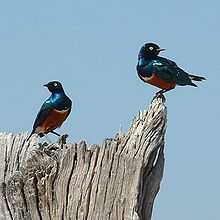Ruaha National Park
| Ruaha National Park | |
|---|---|
|
IUCN category II (national park) | |
 | |
 | |
| Location | Tanzania |
| Nearest city | Iringa |
| Coordinates | 7°30′S 35°0′E / 7.500°S 35.000°ECoordinates: 7°30′S 35°0′E / 7.500°S 35.000°E |
| Area | 13,000 square kilometres (5,000 sq mi) |
| Established | 1964 |
| Governing body | TANAPA |
Ruaha National Park is the largest national park in Tanzania. It covers an area of about 13,000 square kilometres (5,000 sq mi).[1] It is located in the middle of Tanzania about 130 kilometres (81 mi) from Iringa. The park is part of a more extensive ecosystem, which includes Rungwa Game Reserve, Usangu Game Reserve, and several other protected areas.
The name of the park is derived from the Great Ruaha River, which flows along its south-eastern margin and is the focus for game-viewing. The park can be reached by car via Iringa and there is an airstrip at Msembe, park headquarters.
History

The creation of a national park in this area was first proposed in 1949 by the senior game ranger in Mbeya, George Rushby. In 1951, it was gazetted by the British colonial authorities as an extension of the neighbouring Rungwa Game Reserve. People living in the new protected area were subsequently forced to move out. In 1964, it was excised from the game reserve and elevated to full park status. In 2008, it was extended to incorporate the former Usangu Wildlife Management Area, in the upper Ruaha catchment, making Ruaha the largest National Park in Africa.

Wildlife
The Ruaha National Park is famous for its large population of elephants, with about 10,000 roaming the park. It is also frequented by birdwatchers, with 436 species having been identified of an estimated total of 475. Among the resident birds are different species of Hornbills, Kingfishers and Sunbirds. Also many migrants visit Ruaha, e.g. the White Stork
Other special animals in Ruaha are the African Wild Dog and the Sable Antelope. Rhinoceros were last been sighted in 1982 and are probably extinct in the park due to poaching.
The best times to visit for predators and large mammals is the dry season (May–December) and for birds and flowers, the wet season (January–April).
Environmental change
The park is currently facing a significant environmental challenge from the progressive drying up of the Great Ruaha River. The river used to flow all year round, but since 1993 there have been increasingly long periods every dry season in which it has dried up completely. Different hypotheses have been advanced to account for this, and one view is that it is caused by the expansion of irrigation schemes for rice cultivation and growth of livestock keeping in the Usangu wetland, which feeds the Great Ruaha River (Fox 2004).
Accommodation
There are six lodges in Ruaha: Tandala Tented Camps, Mwagusi Safari Camp, Mdonya Old River Camp, Ruaha River Lodge, Kwihale and Jongomero Camp. There are also several park run public campsites.
References
External links
| Wikimedia Commons has media related to Ruaha National Park. |
- Ruaha National Park Information
- TANAPA, Tanzania National Parks
- TANAPA, Ruaha National Park
- Friends of Ruaha Society
- Map of Ruaha National Park
| |||||||||||